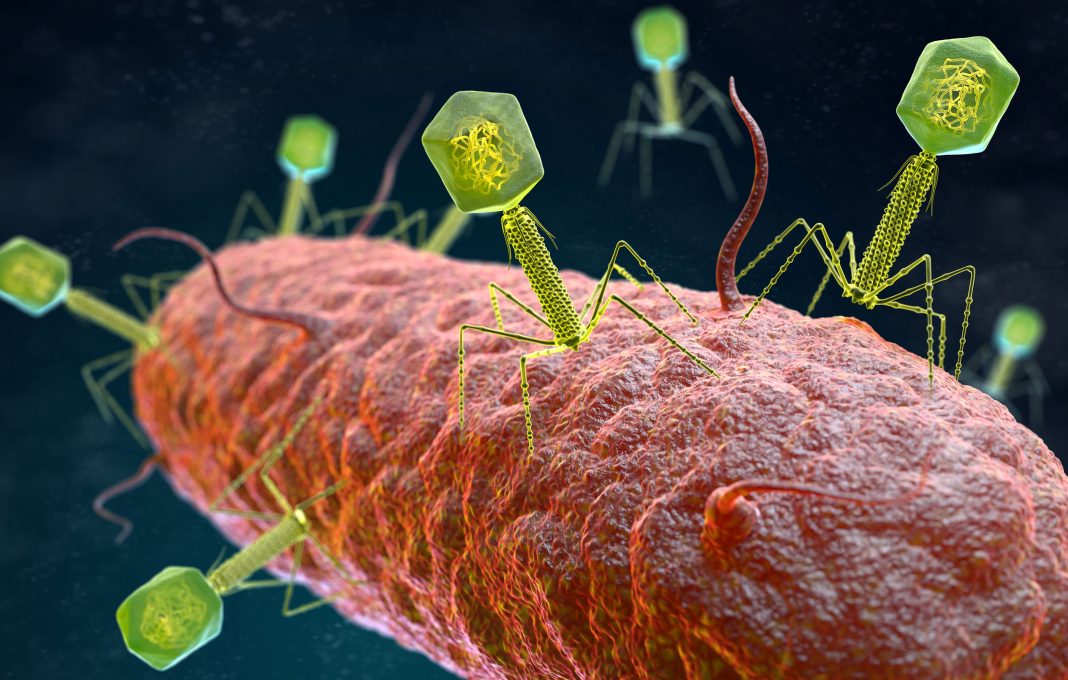There’s nothing retro about retrons, which are bacterial molecules that produce DNA. Although retrons ordinarily serve an immune function in bacteria, they can, upon modification, acquire a genetic engineering style all their own. Indeed, retron ensembles may become all the rage in phage therapy.
At present, phage therapy relies on phage editing techniques that often lack elegance. They require laborious screening, counterselection, or in vitro construction of modified genomes. To avoid these problems, scientists at the Gladstone Institutes led by associate investigator Seth Shipman, PhD, have been developing a sleeker, retron-oriented approach.
Shipman’s team has found ways to program retrons so they make copies of a desired DNA sequence. When phages infect a bacterial colony containing retrons, the phages integrate the retron-produced DNA sequences into their own genomes.
“Ultimately, if we want to use phages to save the lives of people with infections that are resistant to multiple drugs, we need a way to make and test lots of phage variants to find the best ones,” Shipman said. “This new technique lets us successfully and rapidly introduce different edits to the phage genome so we can create numerous variants.”
Details about the retron approach recently appeared in Nature Biotechnology, in an article titled, “Continuous multiplexed phage genome editing using recombitrons.” Recombitrons are what the Gladstone team calls bacterial retrons that have been modified to produce DNA sequences specifically designed to edit invading phages. To accomplish this task, recombitrons generate recombineering donor DNA paired with single-stranded binding and annealing proteins for integration into phage genomes.
“[Our recombitron] system can efficiently create genome modifications in multiple phages without the need for counterselection,” the article’s authors reported. “The approach also supports larger insertions and deletions, which can be combined with simultaneous counterselection for >99% efficiency. Moreover, we show that the process is continuous, with more edits accumulating the longer the phage is cultured with the host, and multiplexable.”
Unlike antibiotics, which broadly kill many types of bacteria at once, phages are highly specific for individual strains of bacteria. As rates of antibiotic-resistant bacterial infections rise, researchers are increasingly looking at the potential of phage therapy as an alternative to combat these infections.
Already, phages have been successfully used in the clinic to treat a small number of patients with life-threatening antibiotic-resistant infections, but developing the therapies has been complex, time-consuming, and difficult to replicate at scale. Doctors must screen collections of naturally occurring phages to test whether any could work against the specific bacteria isolated from an individual patient.
Shipman’s group wanted to find a way to modify phage genomes to create larger collections of phages that can be screened for therapeutic use, as well as to collect data on what makes some phages more effective or what makes them more or less specific to bacterial targets.
Shipman and his colleagues began by putting their recombitrons into colonies of bacteria. Then the scientists let phages infect the bacterial colonies. As the phages infected bacteria after bacteria, they continuously acquired and integrated the new DNA from the recombitrons, editing their own genome as they went along.
The research team showed that the longer they let phages infect a recombitron-containing bacterial colony, the greater the number of phage genomes were edited. Moreover, the researchers could program different bacteria within the colony with different recombitrons, and the phages would acquire multiple edits as they infected the colony.
In the current study, the scientists installed up to five distinct mutations on a single lambda phage genome without counterselection in only a few hours of hands-on time. “As a phage is bouncing from bacterium to bacterium, it picks up different edits,” Shipman noted. “Making multiple edits in phages is something that was previously incredibly hard to do; so much so that, most of the time, scientists simply didn’t do it. Now, you basically throw some phages into these cultures, wait a while, and get your multiple-edited phages.”
Shipman’s team is working on increasing the number of different recombitrons that can be put into a single bacterial colony—and then passed along to phages. They expect that eventually, millions of combinations of edits could be introduced to phages to make huge screening libraries.
“We want to scale this high enough, with enough phage variants, that we can start to predict which phage variants will work against what bacterial infections,” Shipman related. Ultimately, the goal is to create phage genome ensembles that bacteria could be expected to die for.


